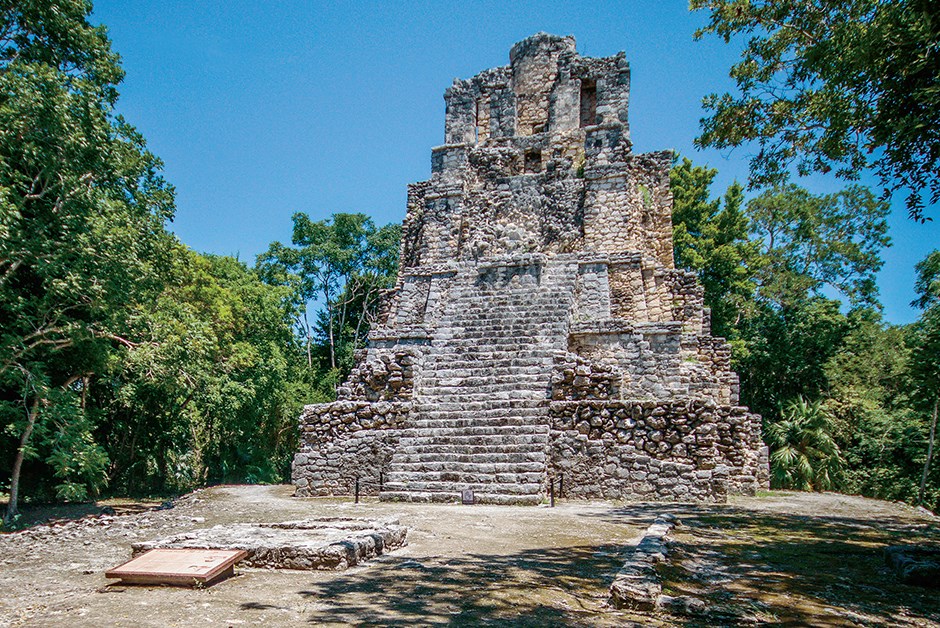Where to Go on Mexico’s Yucatán Peninsula
A world of natural beauty lies off the beaten path on the Yucatán Peninsula.
There’s only so much lazing on the beach you can do before a change of scenery is in order, a diversion to put you more in touch with nature and the pristine allure of Mexico. With its crystal-clear ponds, silent jungle ruins and abundance of wildlife, Riviera Maya has natural wonders, secret spaces—and a real story to tell.
Go Bird-Spotting
With a huge number of bird species, both migratory and endemic, birding tours are popular and plentiful in this neck of the woods. Various local guides offer jaunts into places like the jungle of Puerto Morelos or the Sian Ka’an Biosphere Reserve near Tulum, teaching visitors about the Yucatán ecosystem and spotting exotic birds like toucans, green jays, honeycreepers, roseate spoonbills, parrots, orioles and more. Not only will these outdoor adventures yield birds from the jungle, but also marine species from the channels and mangroves closer to the sea.

A Mexican green jay
See the Natural Beauty
The ancient archaeological site of Muyil, about 56 miles (90 kilometers) south of Fairmont Mayakoba, is one of the first Mayan settlements, inhabited as early as 300 BC, and also one of the longest to be occupied, up to about 1500 AD. In its day, the 48-structure city was an important stop on the Caribbean trade route, welcoming dealers of jade, chocolate, honey, feathers and salt. Today, a hidden boardwalk amid the lush, natural surroundings behind the Kukulcán pyramid leads to an observation tower that offers amazing views of the adjacent lagoon—and the resident monkeys. Or stay in town to discover the early 1900s history of Mexico’s most iconic artist at the recently opened Frida Kahlo Riviera Maya Museum. Discover details of her exuberant life and often controversial work inspired by Mexican iconography and local nature.

Frida Kahlo finds inspiration in local flora and fauna for Self-Portrait with Thorn Necklace and Hummingbird
Explore the Neighborhood
Canoeing or ziplining can really amp up a day of communing with nature. At Tankah Natural Park, an ecological adventure area near Tulum, you can do all three. The park also has a traditional Mayan community living within its borders, so you can experience a preserved heritage first-hand. It’s communities like this who have donated hives of rare Melipona bees native to the Yucatán to Fairmont Mayakoba, which nurtures on-property apiaries and further fosters the medicinal benefits of bee pollen and honey.

Canoeing in Tankah Natural Park
Feast on Freshness
Nature’s bounty is evident in the quality of the Mayan region’s wholesome cuisine. Start at the Fairmont Mayakoba, where fresh local ingredients from land and sea headline the daily menus. Venturing out to a traditional Mayan lunch will introduce you to a world of natural flavors. Be sure to try the rich and succulent chicken done in clay pots over an open fire, as well as the poc chuc: slow-roasted pork made with sour orange juice and topped with onions and coriander.

Fresh lobster at Fairmont Mayakoba
Swim in the Cenotes
Cool off on a hot day by going for a snorkel in the area’s freshwater cenotes, sinkholes fed by underground streams and rivers. Visitors can discover stalagmites and caverns, and see fossils embedded right in the rock bed. Many cenotes are attached to little amusement parks featuring activities like ziplining, but the ones off the beaten path are the most special. A peaceful cenote at the back of the Xel-Há archaeological site is a well-kept secret. And if you’re visiting the turtle sanctuary at X’cacel Beach, donate a few pesos to help fund the research that goes on there—and also to gain entry to the small mangrove cenote hidden in the jungle close to the shore.

Yucatán’s Ik Kil cenote is considered sacred by locals
By Doug Wallace
